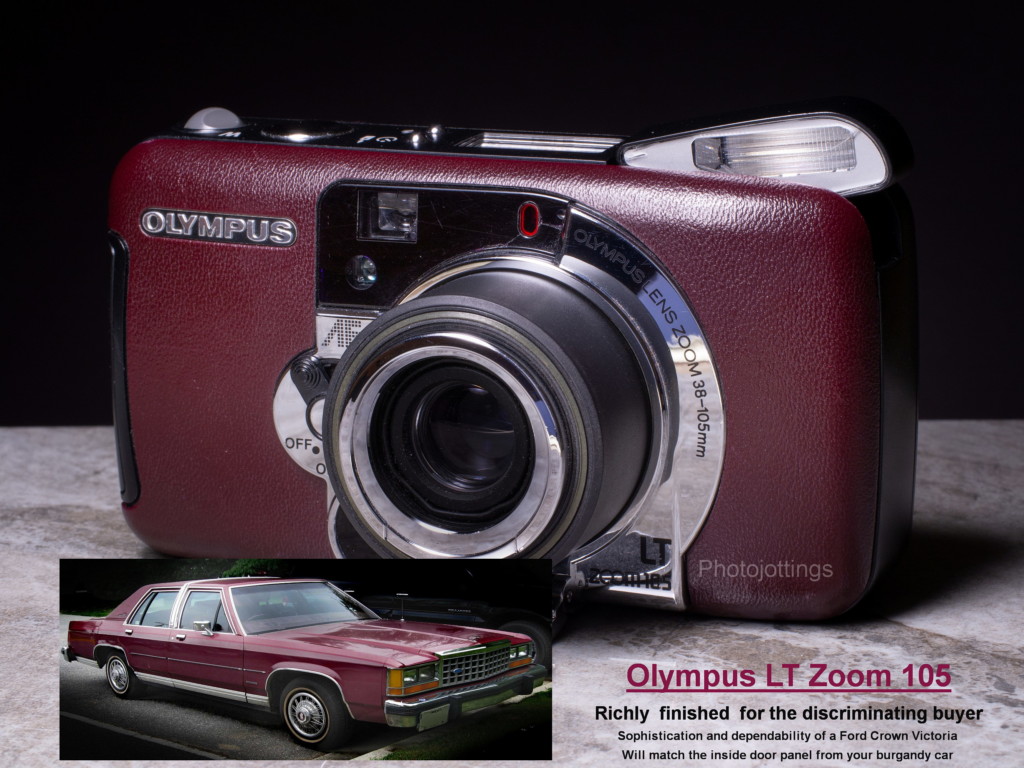
Our review camera for today is the compact and elegant Olympus LT Zoom 105, featuring a rich ‘Leather Tech’ outer cover which actually appears to be an automotive grade naugahyde, but it still looks pretty neat, that’s why I bought it—unfortunately I think I got ripped off, see the test shots below.
Olympus offered at least two models of the ‘LT’ series, the Zoom 105 with a 38-105mm lens, and an LT-1 prime with 35/3.5 and a faux leather flap lens cover. I see four colors available, burgundy, brown, black and a greenish one. Later versions include a quartz date and panorama mode.
The stylish Olympus LT Zoom 105 ca. 1997 is a fully automatic point and shoot camera, with auto focus, auto exposure, auto advance and rewind, and an automatic pop-up flash. As with most point and shoot cameras, there are only a few settings to choose from, like flash on-off, red eye reduction, fill flash, spot focusing and metering, long exposure mode up to 4 seconds, a self timer and optional RC-200 remote control. The camera is marketed as ‘weatherproof’ and ‘all weather ,’ but will only repel light rain, and won’t withstand being submerged in water.
So is the Olympus LT Zoom 105 just another pretty ‘accessory’ camera, or can it take excellent pictures? let’s find out now!
Name; Olympus LT Zoom 105; plain versions were known as ‘Stylus Zoom 105,’ and ‘mju zoom 105‘ in Japan.
Box contents; camera, owner’s manual, a matching color wrist strap and maybe a vinyl carrying case.
Manufactured by; Olympus Optical Co, LTD, Tokyo, Japan.
Made in: Japan.
Date of manufacture; 1997-?
Price; retail probably around $249 at introduction. A 1999 mail order NY City super store magazine ad price is $189. Current ebay prices are around $50-150 for a good used copy. Get the same basic camera for half the price by buying the ‘Stylus Zoom 105,’ or ‘mju zoom 105‘
Build material; mostly plastic body.
Weight; camera with batteries, 9.4oz (268g).
Dimensions; Size is 4.75″ (121mm) wide, 2.6″ (66mm) high, and 1.85″ (47mm) deep.
Focal length; 38-105mm.
Aperture; F/4.5-8.9, not user selectable.
Focusing; active type infrared auto focus, 2.0′ (0.6m) to infinity.
Original print size; standard over-sized prints 4 x 6.″
Approximate resolution; probably will make excellent 5″x 7,” and very good 8″x 10″ prints. My copy would not make any good prints due to poor focusing.
Lens; 38-105mm F/4.5-8.9 multi-coated glass, six elements in five groups design.
Shutter and speed; four? aperture blades, speed from 4 seconds to 1/500s but not user adjustable. Self timer with Remote control option.
Distortion; looks mild from the pictures below.
Good features; fill flash, 12 second timer, spot focus and metering, eyepiece diopter adjustment, and long exposure mode up to 4 seconds.
Film; all 135 film cartridges, B&H, Amazon, eBay.
Flash. built-in pop-up type, 15′ (4.7m) at ISO 100, 4 second recharge time with fresh batteries.
Power; One 3 volt DL123A/CR123A battery. B&H, Amazon.
Viewfinder; Real image zoom viewfinder (with autofocus mark, close-up correction marks, green autofocus indicator and orange flash indicator lights on the side of the viewfinder; solid green means focus is locked, and you’re good to shoot, blinking green means it isn’t focused properly. Solid orange means the flash is charged and ready; blinking orange means the flash is not ready.
DX coding; 50-3200. Defaults to ISO 100 when no code is detected.
Accessories for this model; N/A.
Crippling features and omissions; no exposure compensation setting.
Go here for an owner’s manual.
Product shots with descriptions. Click for larger images.

The power button is on the escutcheon, to the right side of the lens as you hold it. When turned on, the lens and flash pops out and the lens cover swings down.

The lens initially powers on to the wide end, and when at full telephoto, it extends another 52mm. The lens cap must be manually pushed up and closed when the power is turned off. Notice the odd shaped flash sticking out of the top.

Not much to see on the bottom of the camera except the off-center plastic ¼-20 tripod socket, and just above that a mid-roll rewind button.

The back cover has a lot of lovely burgundy naugahyde, interrupted only by a film reminder window. The round knob by the viewfinder is a diopter adjuster; great for people with poor eyesight. The viewfinder is clear and bright, but quite small. The two small lights on the right side of the viewfinder window are; top green for AF confirmation, and bottom orange for flash status.

A look inside of the camera. The DX code reader is at the back of the cartridge compartment. The film pressure plate is plastic, and the film tensioner is spring steel. I see a rubber gasket around the back cover, and thankfully no moltoprene except around the film reminder window.

On top we have the LCD, remote and self timer button, flash button, shutter button and zoom toggle. If you push both the flash and remote buttons, you can bring up the spot focus and metering mode. Notice Olympus put ‘all-weather’ in a highly visible place, but be careful; it’s only for water slashes and light rain. The viewfinder will show the number of shots—additive type, flash mode, battery power level, and the time and date (with the Quartz date model).

The grip side of the camera has the battery door with strap attachment. The little sliding button in the middle is for opening the back cover.

The box with camera. I forgot to take a picture of the matching burgundy hand strap and multi language manual.
Here are some bad test images scanned on a Nikon Super Coolscan 9000 ED. All are 3000 pixels wide; there is no additional resolution from scanning at a higher sample rate. Kodak Gold 200 used for all shots. Click for larger images.
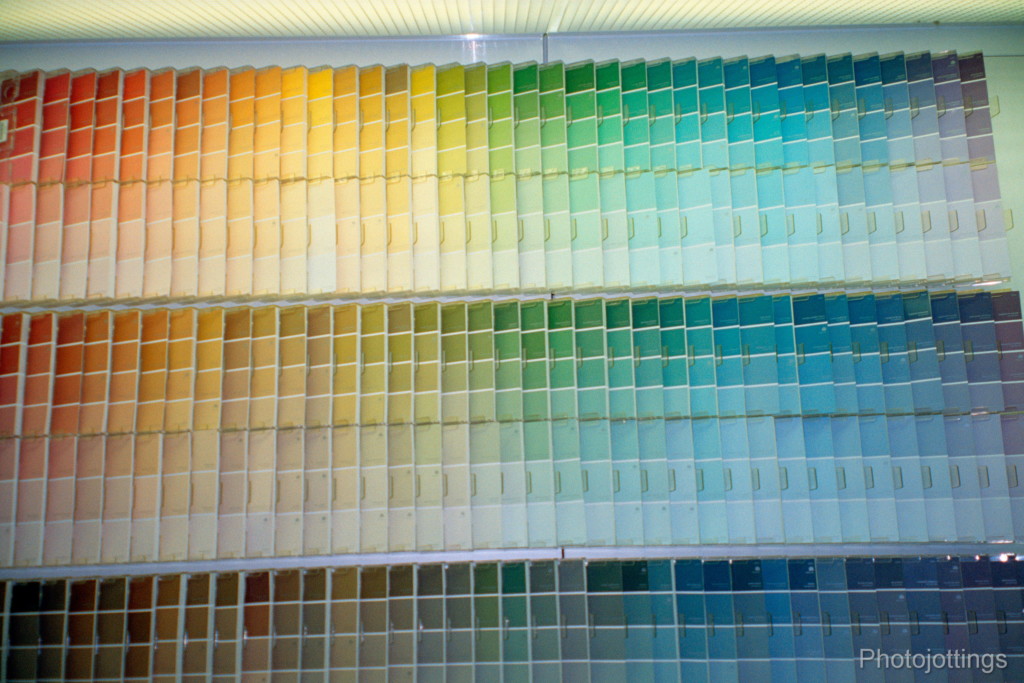
Colorful paint chip display; I see a soft left side.
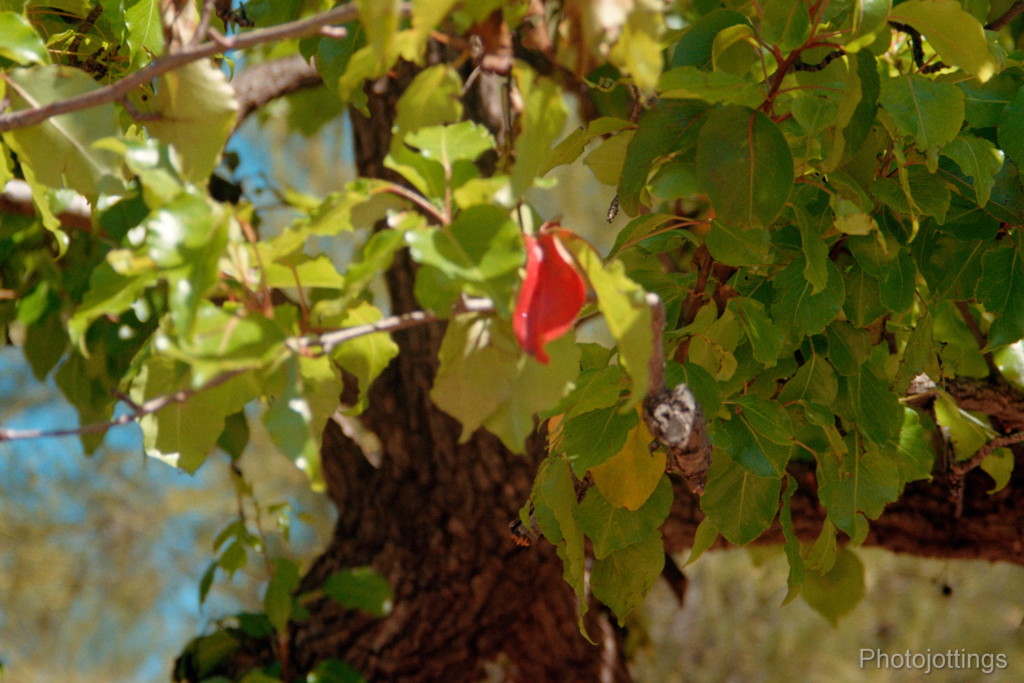
Close focus; I was trying for the red leaf, but it missed the focus.

I’m guessing the lens was close to wide open here, and at 38mm. The left side is soft.

I framed the window to exactly match the viewfinder edges, so there is a lot of extra coverage in the actual frame. I see some minor complex distortion along the window frames.
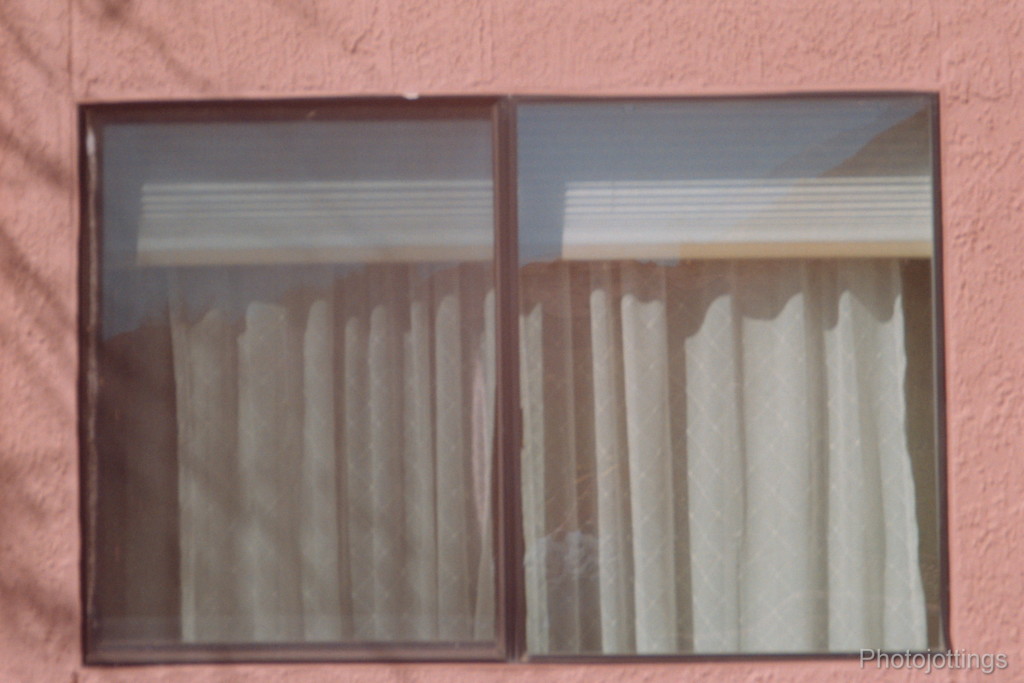
The same thing at the telephoto end; a lot more coverage than what you see through the viewfinder. There doesn’t seem to be much distortion here, but the camera missed focus.
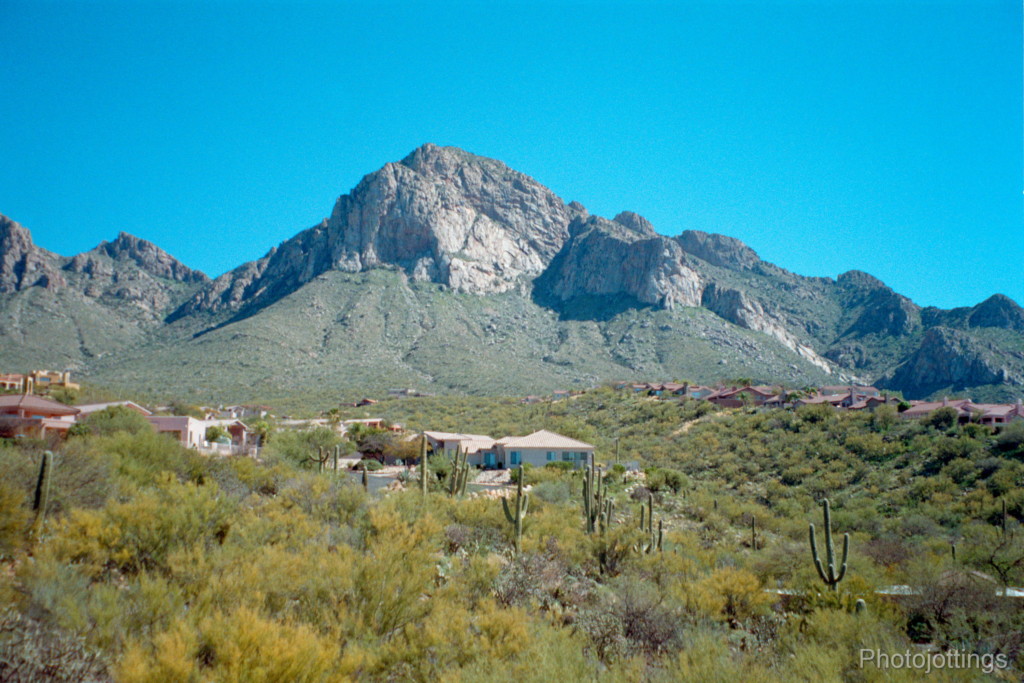
Our normal test scene at 38mm, and way out of focus. The color of the lens looks pretty good though.
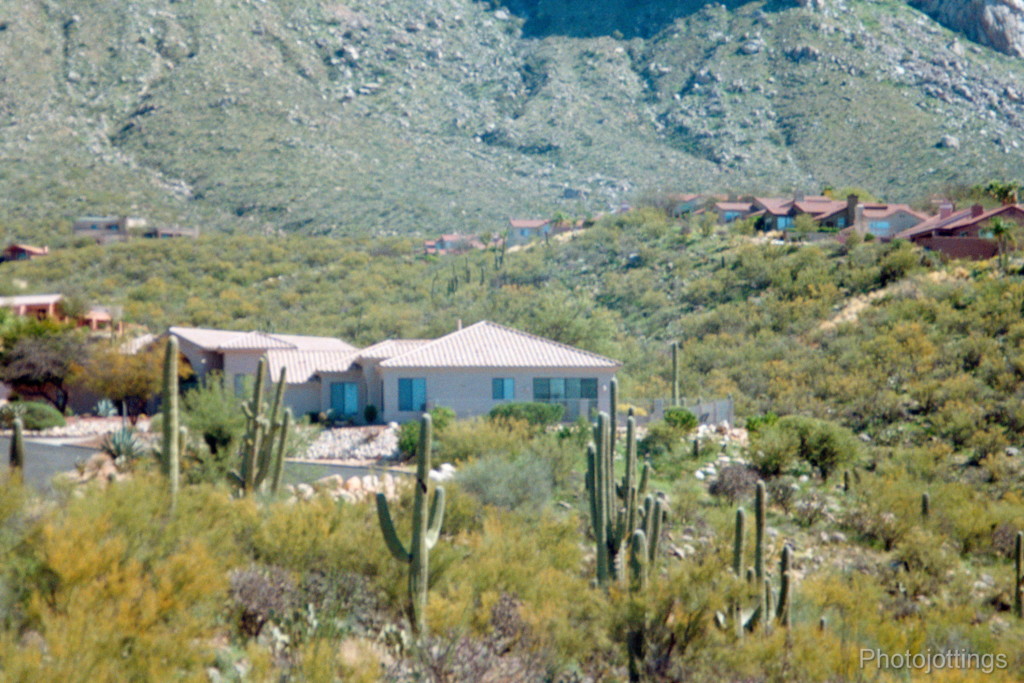
Eh boy, another one out of focus, this time at 105mm. Well, that’s enough of the test shots, let’s stop wasting time and wrap things up.
Conclusion.
The Olympus LT Zoom 105 is a nice looking camera, it’s somewhat unique I think with the finish color and cover material; maybe the green version would be even better looking, but not quite as elegant as burgundy. This little camera will look great in the display cabinet, and unfortunately that’s probably where it’ll stay for the rest of its life.
My copy (purchased via Etsy) would not focus correctly in almost all attempts. Maybe it was dropped or roughly handled at one time. One possible issue; I think the lens extending and simultaneous flash pop-up at power-on are mechanically linked, so if you have your hand over the flash when you turn the camera on, it may cause problems with the lens start-up positioning. I did this by accident and the lens stopped extending and made an odd noise, however, that was after I shot the roll of film, but maybe someone else did that and screwed up the lens—who knows.
I’m guessing a properly operating model would provide quite sharp pictures with good color and contrast, but I think I’m done for now. I might try a prime lens (LT-1) model in green next if I find a good one.
So maybe a thumb and a half up for a correctly working model, but two thumbs down for my copy; oh well, at least I gave it a decent try. For a much better model (and way less expensive) in this category, check out the Minolta Freedom Zoom 160 I reviewed here, or the super inexpensive and excellent Canon zoom here.
That’s it for this review, thanks for visiting!
Please consider buying your goodies through my links, doing so helps support the site, thanks!